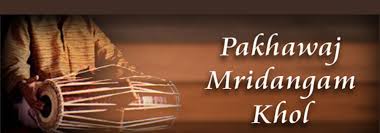
"Mridangam and Pakhawaj: The Reverberating Rhythms of Classical Percussion"
In the rich tapestry of classical Indian music, percussion instruments hold a sacred place, embodying the heartbeat, rhythm, and soul of melodies. Among these, the Mridangam and Pakhawaj stand as iconic instruments—each carrying centuries of tradition, cultural significance, and rhythmic prowess within their resonating skins. Let's embark on a rhythmic journey to explore the Mridangam and Pakhawaj—unveiling their distinct characteristics, historical roots, playing techniques, and enduring contributions to the world of classical music.
Mridangam: Rhythmic Poetry from South India
Origins and Tradition:
The Mridangam, originating from South India, holds a revered status in Carnatic music. Its origins trace back to ancient scriptures and mythology, where it finds mention as an instrument accompanying celestial music and rituals.
Design and Technique:
Crafted from a single piece of wood, the Mridangam features two distinct heads—'Valanthalai' (right side) and 'Idanthalai' (left side)—each producing contrasting tones. Skilled percussionists use fingers, palms, and wrists to create intricate rhythms, exploring various 'thaalams' (rhythmic cycles) and 'korvais' (patterns) within compositions.
Melodic Synchronization:
The Mridangam is unique in its ability to complement melodic phrases and intricate rhythms of Carnatic music. Its dynamic range, tonal variations, and ability to echo the melodic patterns ('solkattu') render it indispensable in classical concerts and accompaniments.
Pakhawaj: The Heartbeat of North Indian Classical Music
Historical Roots:
The Pakhawaj, deeply rooted in North Indian classical music, traces its lineage to ancient texts and courtly traditions. It served as the primary percussion accompaniment in Dhrupad music, echoing the spiritual ethos of its melodies.
Construction and Playing Style:
Crafted from wood and covered with layered skins, the Pakhawaj's unique design enables a deep, resonant bass sound on one side ('bass head') and a sharper, textured tone on the other ('treble head'). The player uses hand techniques and intricate strokes to explore the rhythmic intricacies of 'laya' (tempo) and 'taal' (rhythmic cycles).
Spiritual Significance:
The Pakhawaj's association with devotional music and the spiritual ambiance of Indian classical music enhances its significance. It has historically accompanied the introspective and meditative tones of Dhrupad singing, serving as a spiritual medium for musical expression.
Uniting Threads: Percussive Harmony
Though geographically distinct, the Mridangam and Pakhawaj share a common ethos—their ability to evoke emotions, accentuate melodies, and set the rhythmic foundation for classical compositions. Both instruments serve as pillars of the intricate rhythmic tapestry woven into the fabric of Indian classical music.
Conclusion: Rhythmic Legacies, Eternal Beats
As the Mridangam's resonant beats merge with the Pakhawaj's deep echoes, they echo the timeless legacy of classical percussion. These instruments stand not just as percussion accompaniments but as melodic storytellers, articulating the nuances, emotions, and cultural heritage of classical Indian music.
Their rhythmic eloquence and cultural significance transcend mere beats, resonating through the ages—a testament to the profound beauty and enduring legacy of classical percussion in the symphony of human expression.
The Mridangam and Pakhawaj's intricacies and cultural significance in classical Indian music are truly captivating, illustrating the profound rhythmic traditions within the world of percussion.
ABOUT AUTHOR : Musicintuit Admin
EXPLORE OUR ARRAY OF ONLINE MUSIC COURSES: Musicintuit Courses
ENROLL TODAY ! EXPLORE AND IMMERSE YOURSELF IN THE REALM OF MUSIC: Contact Musicintuit




